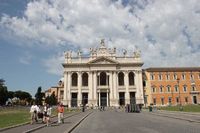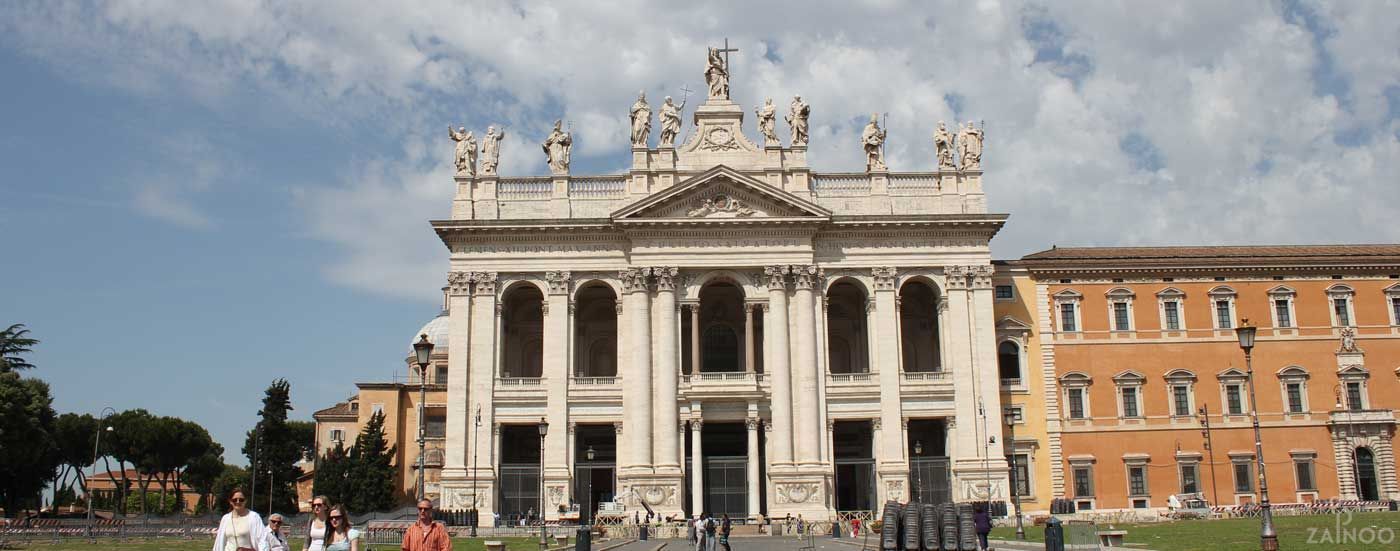San Giovanni in Laterano
Cathedral
St. John Lateran
The Episcopal Church of the Pope
"Mother and head of all the churches of the city and of the earth" is emblazoned in Latin on the base of the portico of the Lateran Basilica. St. John Lateran is the cathedral of the Pope and the highest ranking basilica, outranking even St. Peter's Basilica, Santa Maria Maggiore and San Paolo Fuori le Mura. It was built in the 2nd Century on the property of the Roman general Sextius Lateran and assumed its present appearance after several renovations in the 17th Century.
The Lateran Basilica from outside
The main façade of St. John Lateran dates from the 18th Century. The approximately 7 metre high sculpture of Christ, the patron saints and teachers of the church are an early classical work by Alessandro Galilei. Worth seeing at the entrance are the bronze doors at the main entrance, which originate from the Roman Forum and the Porta Santa at the far right. The five-nave early Christian basilica is divided into a nave and a transept.
Attractions in the church of St. John Lateran
The main nave is flanked inside by powerful twin pillars of Borromieri. In contrasting coloured niches are monumental figures of the apostles from the 18th Century, Old and New Testament stucco reliefs by Algardi as well as painted prophets of the 17th Century. The nave is covered by a gilded wooden ceiling from the 16th Century.
The Tabernacle was erected by Giovanni di Stefano above the papal altar in 1367. Here are the relics of Peter and Paul in silver busts. According to tradition, the first popes including Peter led mass at the wooden altar. Also worth seeing is the bronze tomb of Pope Martin V in front of the Confessio, which was built by Donatello. In the apse you can finally see early Christian mosaics depicting Christ surrounded by angels and saints.
The cloister, which is accessed from the left aisle dates from the 13th Century and impresses with elaborate columns and Cosmati ornamentation of the Vassaletti family of sculptors.
Baptistery and Palazzo Laterano
If you leave San Giovanni in Laterano by the right aisle, you can see the Baptistery of San Giovanni in Fonte on the left. It dates from the 4th Century and was built by the Emperor Constantine. Under Pope Sixtus III it received porphyry columns around the font. The octagonal floor plan alludes to the eighth day of creation, when man was baptized. Directly on the right side of the church is the Lateran Palace. Until the return of the popes from exile in France in 1378, it was the official residence of the popes. Only in 1378 the popes moved to the Apostolic Palace in St. Peter. The present building was commissioned by Pope Sixtus V and extended into a summer residence. In 1929, the Lateran Treaty was signed here with the Italian state.
Piazza San Giovanni in Laterano and Santa Scala
The wide square in front of the church was created in 1584 by Domenico Fontana. The 31 metre high obelisk is the tallest and oldest obelisk in Rome. It was brought to Rome from Thebes in 357 and was previously at the Circus Maximus. The small church of Scala Santa (Holy Stairs Church) was built by Pope Sixtus V in 1590. It houses the former papal private chapel with beautiful mosaics from the 13th Century. The holy staircase consists of 28 marble steps (now covered with wood), which were brought to Rome from the palace of Pilate in Jerusalem by St. Helena in the 4th Century.















Tweet